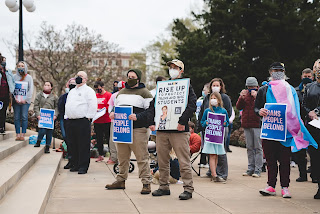FYS Final Paper: Marriage Rights In the United States
“...the absence of anti-miscegenation statutes in some states should not be considered as evidence that such marriages are approved there or that there is a popular indifference to them. Rather, the lack of such laws frequently reflects the fact that Negroes and Orientals are a negligible part of the population in these states, and that [sic] intermarriages are so few that the question can be ignored”(Browning).
Thus, popular sentiment surrounding miscegenation around and after the time of Loving v. Virginia was not in favor of racial integration. Momentum towards the preservation of racial purity was not halted or reversed by Loving v. Virginia as white Americans were “implicated
“Decisions of individuals relating to homosexual conduct have been subject to state intervention throughout the history of Western civilization. Condemnation of those practices is firmly rooted in Judeo-Christian moral and ethical standards. Homosexual sodomy was a capital crime under Roman law”(Bowers, Attorney General of Georgia v. Hardwick et Al..,).
Mentions of Western civilization, Judeo-Christian moral and ethical standards, and sodomy laws allude to marriage as a relic of religious traditions (Cornell Law). Marriage denotes a contract between a man and a woman. The relationship between a man and a woman is patriarchal in nature, modeled after traditional Abrahamic gender roles that in many ways still persist today. Although the gender categories of man and woman are socially constructed, the implications and pervasiveness of the abovementioned gender binary are far-reaching (Lorber). Expectations thrust upon men to be strong, emotionless, rational, breadwinners and women to be gentle, emotional, ditzy, homemakers scaffold current social and legal structures in the United States. These expectations and associations, termed “scripts,” are the foundation to the social institution of marriage that is widely regarded as occurring between a man and a woman for the purpose of procreation (Wideman). In 1996, the Defense of Marriage Act cemented this traditional view of marriage into law (signed by President Bill Clinton), asserting that states did not have to recognize same-sex marriages external to their state and echoing public sentiment that marriage occurred ”between a man and a woman for purposes of Federal law”(Legal Information Institute). It was not until 2013 that Section 3 of DOMA was repealed by the Supreme Court in the case United States v. Windsor, given that the “federal government cannot discriminate against married lesbian and gay couples for the purposes of determining federal benefits and protections”(NYCLU). The most recent and wide-reaching win for the gay and lesbian community in court was the Supreme Court case Obergefell v. Hodges that legalized same-sex marriage nationwide in 2015, citing state regulation and impediment on same-sex marriage was a violation of the Equal Protection Clause, while issue of a state not recognizing another’s marriages as a violation of the Due Process Clause (Cornell Law). Despite the magnitude of this expansion of gay rights, the plasticity of marriage remains in both legal and social arenas.
Works Cited
Bowers, Attorney General of Georgia v. Hardwick et Al.., tile.loc.gov/storage-services/service/ll/usrep/usrep478/usrep478186/usrep478186.pdf. Accessed 22 Nov. 2023.
Browning, James R. “Anti-Miscegenation Laws in the United States.” Duke Bar Journal, vol. 1, no. 1, 1951, pp. 26–41. JSTOR, https://doi.org/10.2307/1370809. Accessed 22 Nov. 2023.
“Defense of Marriage Act (DOMA).” Legal Information Institute, Legal Information Institute, www.law.cornell.edu/wex/defense_of_marriage_act_(doma). Accessed 21 Nov. 2023.
Eskridge, William N., et al. Sexuality, Gender, and the Law. Fifth edition., Foundation Press, 2023.
Haney Lopez, Ian F. “The Social Construction of Race: Some Observations on Illusion, Fabrication, and Choice.” Harvard Civil Rights-Civil Liberties Law Review, vol. 29, no. 1, 1994, pp. 1-.
Judith Lorber. “Night to His Day: The Social Construction of Gender.” Paradoxes of Gender, Yale University Press, 1994, pp. 13-.
Lenhardt, Robin A. “Beyond Analogy: Perez v. Sharp, Antimiscegenation Law, and the Fight for Same-Sex Marriage.” Fordham Law School, 2008.
Levy, Michael. "Underwood-Simmons Tariff Act". Encyclopedia Britannica, 3 Apr. 2023, https://www.britannica.com/event/Underwood-Simmons-Tariff-Act. Accessed 21 November 2023.
“Loving v. Virginia.” Legal Information Institute, Cornell Law, www.law.cornell.edu/wex/loving_v_virginia_(1967)#:~:text=Primary%20tabs-,Loving%20v.,Clause%20of%20the%20Fourteenth%20Amendment. Accessed 21 Nov. 2023.
“Marriage.” Legal Information Institute, Cornell Law, www.law.cornell.edu/wex/marriage. Accessed 21 Nov. 2023.
Radde, Kaitlyn. “What Does the Respect for Marriage Act Do? The Answer Will Vary by State.” NPR, NPR, 8 Dec. 2022, www.npr.org/2022/12/08/1140808263/what-does-the-respect-for-marriage-act-do-the-answer-will-vary-by-state.
Stein-Alvarado, Ray. “Final Paper: FYS 6 Paper #3: Gender & Sexuality, Law & Marriage.” RAYSFYSBLOGWITHAGREATTITLE, Blogspot, https://downloadfreeramtoday.blogspot.com/
Supreme Court of the United States - United States Department of Justice, www.justice.gov/sites/default/files/crt/legacy/2015/06/26/obergefellhodgesopinion.pdf. Accessed 22 Nov. 2023.
Supreme Court of the United States, www.supremecourt.gov/opinions/21pdf/19-1392_6j37.pdf. Accessed 22 Nov. 2023.
“We Talk to Interracial Couples 50 Years after Loving v. Virginia (HBO).” YouTube, 13 June 2017, youtu.be/RseBL4eC0ok?feature=shared.
“Webster’s Dictionary 1828 - Marriage.” Websters Dictionary 1828, American Dictionary of the English Language, webstersdictionary1828.com/Dictionary/marriage. Accessed 21 Nov. 2023.
Wolfe, Contributor: Brendan. “Racial Integrity Laws (1924–1930).” Encyclopedia Virginia: Virginia Humanities, Encyclopedia Virginia, 6 Feb. 2023, encyclopediavirginia.org/entries/racial-integrity-laws-1924-1930/.






Comments
Post a Comment